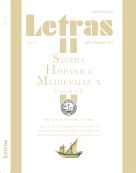Por favor, use este identificador para citar o enlazar este ítem:
https://repositorio.uca.edu.ar/handle/123456789/3784| Campo DC | Valor | Lengua/Idioma |
|---|---|---|
| dc.contributor.author | Marti, Melisa Laura | es |
| dc.date.accessioned | 2019-06-01T18:03:03Z | - |
| dc.date.available | 2019-06-01T18:03:03Z | - |
| dc.date.issued | 2015 | - |
| dc.identifier.citation | Marti, Melisa L. “Peregrinación a la cibdat de gygantes : configuración del imaginario geográfico bíblico en La fazienda de Ultramar” [en línea]. Letras, 72 (2015). Disponible en: https://repositorio.uca.edu.ar/handle/123456789/3784 | es |
| dc.identifier.issn | 0326-3363 | - |
| dc.identifier.uri | https://repositorio.uca.edu.ar/handle/123456789/3784 | - |
| dc.description.abstract | Resumen: Dado que la imaginación medieval del mundo se nutre de ideas directamente heredadas de la Biblia, a menudo en contienda con la exploración empírica del globo terrestre, el estudio de los relatos de viajes en general, y de las guías de peregrinos a Tierra Santa en particular, nos permite comprender el modo en que el hombre de letras medieval se apropiaba del imaginario bíblico para darle forma a un mundo cuyos límites exóticos cobraban familiaridad por ser el escenario de las historias más apreciadas por los lectores de la época. Dentro del repertorio de literatura de viajes hispánica, La fazienda de Ultramar, cuya redacción se habría llevado a cabo a comienzos del siglo XIII, es un texto de singular importancia, por ser una de las más antiguas versiones en romance de la Biblia. No solo es un texto fundacional para una tradición que cambió la forma en que el hombre medieval se acercaba a las Sagradas Escrituras, sino que, debido a su carácter de itinerarium, nos permite conocer el modo en que la Biblia afectaba la imaginación del lector medieval acerca de la geografía de Tierra Santa. Es por ello que el propósito de esta comunicación será analizar el modo en que la estructura de itinerarium incide sobre el tratamiento del texto sagrado y la forma en que la lógica narrativa de los episodios bíblicos se subordina a la geográfica. De esta forma, se intentará echar luz sobre algunas cuestiones que han limitado el estudio de esta obra. | es |
| dc.description.abstract | Abstract: Given that the medieval image of the world is strongly influenced by ideas inherited from the Bible, which often conflict with the empirical exploration of the terrestrial globe, the study of travel literature in general, and of pilgrim’s guides to the Holy Land in particular, allows us to comprehend the way in which medieval authors embraced the biblical imaginary in order to shape the world, whose exotic limits became familiar as they came to be the setting for the stories most valued by contemporary readers. Among the repertory of Hispanic literature, La fazienda de Ultramar, whose composition is supposed to have occurred sometime during the first decades of the thirteenth century, is a text of chief importance attributable to its condition as one of the earliest vernacular versions of the Bible. Not only is it a foundational text of the tradition that would change the way in which medieval men accessed the Holy Scriptures; it also grants us a means to knowing the manner in which the Bible influenced how medieval readers imagined the geography of the Holy Land, because of its itinerarium nature. Therefore, the purpose of this study will be to analyse the way in which the structure of this itinerarium affects the treatment of the holy text, and the fashion in which the narrative logic of the biblical episodes is subjected to geographical depiction. Thus, we will try to clarify a number of matters that have cast a shadow over the study of this work. | es |
| dc.format | application/pdf | es |
| dc.language.iso | spa | es |
| dc.publisher | Universidad Católica Argentina. Facultad de Filosofía y Letras | es |
| dc.rights | Acceso Abierto | es |
| dc.rights.uri | https://creativecommons.org/licenses/by-nc-sa/4.0/ | es |
| dc.source | Letras Nº 72, 2015 | es |
| dc.subject | LITERATURA ESPAÑOLA | es |
| dc.subject | LITERATURA MEDIEVAL | es |
| dc.subject | LITERATURA DE VIAJES | es |
| dc.subject | BIBLIA | es |
| dc.subject | TIERRA SANTA | es |
| dc.subject | ROMANCERO | es |
| dc.title | Peregrinación a la cibdat de gygantes : configuración del imaginario geográfico bíblico en La fazienda de Ultramar | es |
| dc.type | Artículo | es |
| uca.path | Letras|2015 nº 72 | es |
| uca.disciplina | LITERATURA | es |
| uca.filename | /home/data-uca-generic/folder_generic/letras72/peregrinacion-cibdat-gygantes-marti/metadata.xml | es |
| uca.issnrd | 1 | es |
| uca.affiliation | Fil: Marti, Melisa Laura. Universidad de Buenos Aires; Argentina | es |
| uca.orden | 04 | es |
| uca.version | publishedVersion | es |
| item.languageiso639-1 | es | - |
| item.fulltext | With Fulltext | - |
| item.grantfulltext | open | - |
| Aparece en las colecciones: | LETRAS - 2015 nro. 72 | |
Ficheros en este ítem:
| Fichero | Descripción | Tamaño | Formato | |
|---|---|---|---|---|
| peregrinacion-cibdat-gygantes-marti.pdf | 162,01 kB | Adobe PDF |  Visualizar/Abrir |
Visualizaciones de página(s)
143
comprobado en 30-abr-2024
Descarga(s)
80
comprobado en 30-abr-2024
Google ScholarTM
Ver en Google Scholar
Este ítem está sujeto a una Licencia Creative Commons

